ChatGPT Dashboard - Harnessing the Power of ChatGPT for Advanced Data Analysis in Dashboard Builder
Looking for Google Gemini AI in Dashboard Builder? Click Here
In a world increasingly reliant on data-driven insights, the ChatGPT Dashboard emerges as a revolutionary tool, seamlessly integrating cutting-edge artificial intelligence with intuitive visualization capabilities. Offering users a comprehensive platform for analysis, prediction, and decision-making, this innovative dashboard redefines the landscape of data analytics.

Leveraging ChatGPT API for Advanced Data Analysis in Dashboard Builder:
A Comprehensive Overview
In the fast-paced world of data analytics, staying ahead of the curve is essential. That's why we're thrilled to announce the latest breakthrough in ChatGPT Dashboard– the integration of ChatGPT for data analysis. With this powerful new feature, users can now harness the capabilities of OpenAI's Language Model (LLM) to not only analyze data but also generate valuable insights, predict future trends, and receive actionable suggestions on how to improve.
How ChatGPT Integration Is Helpful in Data Analysis:
In the realm of data analytics, the integration of OpenAI API into Dashboard Builder represents a monumental leap forward, unlocking a plethora of capabilities that redefine the landscape of data analysis. From generating observations to predicting future trends and offering actionable recommendations, this integration revolutionizes the way organizations harness their data for informed decision-making and strategic planning. Let's delve into how each aspect of this integration enhances the effectiveness and efficiency of data analysis:
1. Intelligent Data Analysis:
With the OpenAI API at its core, ChatGPT Dashboard transcends traditional data analysis tools by offering intuitive and comprehensive observations. By processing vast amounts of data through sophisticated natural language processing (NLP) algorithms, ChatGPT Dashboard can swiftly identify key insights, trends, and patterns within the data. This enables users to gain a deeper understanding of their datasets without the need for manual exploration, facilitating quicker decision-making and strategic alignment.
2. Predictive Modeling
One of the most compelling features enabled by the OpenAI API integration is predictive analytics. By leveraging historical data and advanced machine learning algorithms, ChatGPT Dashboard can forecast future trends and outcomes with remarkable accuracy. This predictive capability empowers organizations to anticipate market shifts, customer behavior changes, and operational challenges, allowing them to proactively adapt their strategies and stay ahead of the competition. Whether it's predicting sales trends, demand fluctuations, or resource allocation needs, the predictive analytics feature of ChatGPT Dashboard provides invaluable foresight for decision-makers.
With predictive analytics and actionable recommendations, ChatGPT Dashboard helps organizations align their strategies with future trends and emerging opportunities, ensuring they stay ahead of the curve in a rapidly evolving landscape.
3. Personalized Insights and Recommendations
Tailored to the unique needs of each user, the ChatGPT Dashboard goes beyond providing raw data and insights—it offers personalized recommendations for improvement. Drawing on its vast knowledge base and contextual understanding, the dashboard suggests specific strategies and interventions to optimize outcomes. Whether optimizing marketing campaigns, refining product offerings, or improving operational efficiencies, users receive actionable recommendations that drive tangible results.
Beyond providing insights and predictions, ChatGPT Dashboard equipped with OpenAI API goes a step further by offering actionable recommendations for improvement. By analyzing the data and drawing on a vast knowledge base, the platform can suggest specific strategies and interventions to optimize outcomes. Whether it's identifying inefficiencies in processes, recommending targeted marketing initiatives, or highlighting areas for cost savings, the suggestions for improvement feature empowers organizations to make data-driven decisions that drive tangible results and foster continuous improvement.
By providing comprehensive observations and insights, ChatGPT Dashboard empowers decision-makers at all levels to make informed choices based on data-driven evidence, mitigating risks and maximizing opportunities for success.
How ChatGPT API Works with Dashboard Builder
ChatGPT API is built upon OpenAI's GPT (Generative Pre-trained Transformer) architecture, a state-of-the-art deep learning model for processing and generating natural language text. It utilizes large-scale training data and advanced machine learning techniques to understand and generate human-like responses to textual input.
The integration of ChatGPT API with Dashboard Builder introduces a powerful solution for data analysis, leveraging advanced natural language processing (NLP) capabilities to extract insights from textual data. This document provides a detailed overview of how ChatGPT API works within Dashboard Builder to enable efficient and effective data analysis.
The integration of ChatGPT API with Dashboard Builder facilitates data analysis through the following steps:
- Data Input: Users provide textual data to Dashboard Builder for analysis. This data can include unstructured text from various sources such as customer reviews, social media posts, emails, or any other text-based data relevant to the analysis.
- Text Processing: Dashboard Builder sends the input text to the ChatGPT API for processing. The API tokenizes the text, breaking it down into smaller units such as words or subwords, and encodes it into a numerical format suitable for analysis using the GPT model.
- Analysis and Generation of Insights: ChatGPT API analyzes the processed text using its pre-trained language model. It identifies patterns, relationships, and key insights within the data, leveraging its contextual understanding and knowledge base to generate valuable insights.
- Integration with Dashboard Builder: The insights generated by ChatGPT API are seamlessly integrated into Dashboard Builder's interface. Users can view the analysis results in the form of structured data, visualizations, or natural language summaries, depending on their preferences and requirements
How to create Dashboard using ChatGPT
Step-by-Step User Guide: Using ChatGPT API for Data Analysis in Dashboard Builder
APPLIES TO: On-premises Online Desktop
Step 1 - API Token Creation:
- Go to the OpenAI website and sign in to your account.
- Navigate to the API Key section and select the option to create a new Secrete Key.
- Follow the prompts to generate a new token, providing any necessary information such as project name and purpose.
- Once the token is created, copy it to your clipboard or save it in a secure location. This token will be used to authenticate your requests to the ChatGPT API.
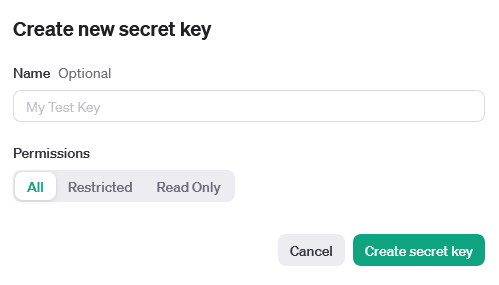
Step 2 - Integration with Dashboard Builder:
- Log in to Dashboard Builder using your credentials.
- Navigate to the settings section of Dashboard Builder.
- Under the AI Integration section, enable AI Integration by clicking the Yes button..
- Select the radio button for ChatGPT.
- Enter the API token you generated earlier into the secret API keys.
- If you want to enable caching, check the Cache Enable button.
- Finally, click the Save Changes button to apply the settings.
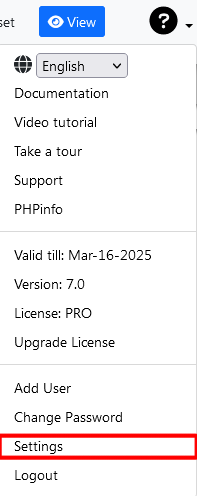

Step 3 - Initiating Data Analysis
- Click on the chart you wish to view and export data from.
- Click on "Edit" > "Chart Settings" button, or simply double click the top bar of the chart.
- In the Chart Settings Window, extend the Properties setting panel.
- Select the "Show Analyze Data" option to enable Data Analysis
- If you prefer to restrict access, you can choose the "Hide" option for Data Analysis.
- Save the changes by clicking the "Save Changes" button.
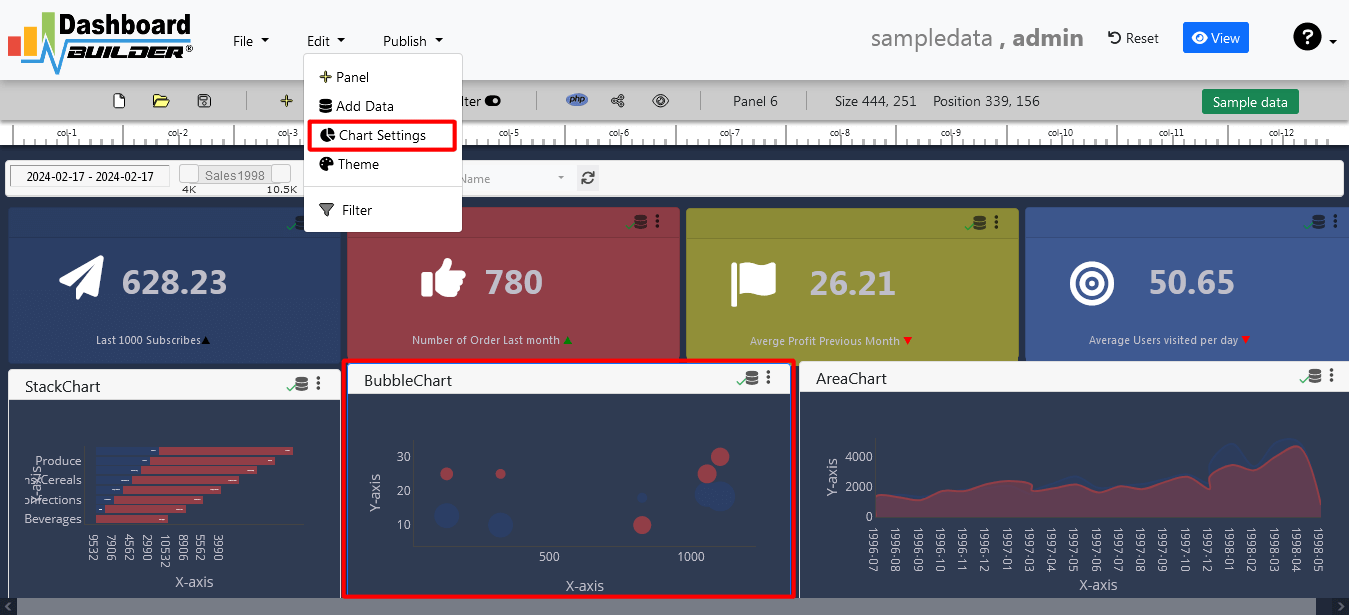
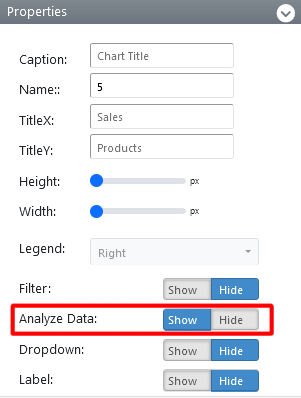
Step 4. Reviewing Data Analysis Results
Once the analysis is complete, review the results provided by ChatGPT API:
- View the report containing the chart you're interested in the insights and findings from the analysis to generate a graph within Dashboard Builder
- Hover over the chart.
- Click on the "Analyze Data" icon.
- A popup window will appear displaying the data analysis report

Understanding the Data Analysis Report
The analysis results, including the graph and table generated earlier, into the report providing detailed Data Analysis with the following sections:
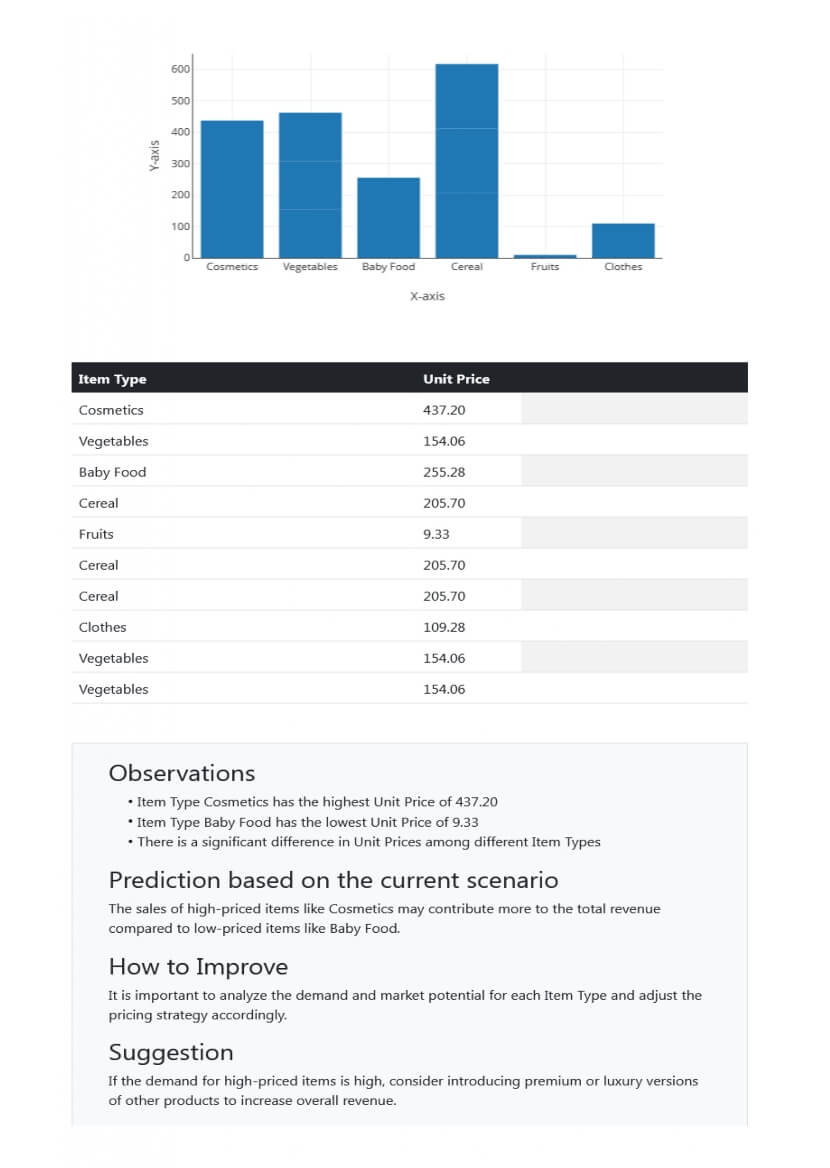
Data export functionality in Dashboard Builder is designed to streamline the process of transferring chart data into CSV format. Here's what you need to know:
- Observations: Summarize key observations and insights derived from the data analysis. Highlight trends, patterns, or anomalies identified in the data.
- Prediction: Utilize predictive analytics to forecast future trends or outcomes based on the analysis results. Provide insights into potential future developments or changes.
- How to Improve: Analyze the current state of affairs and suggest strategies or interventions to improve performance or optimize outcomes based on the analysis findings.
- Suggestions: Offer actionable recommendations for addressing identified challenges or leveraging opportunities uncovered during the analysis process.
Saving and Sharing the Report:
- Save the data analysis report within Dashboard Builder for future reference or sharing.
- Choose the appropriate sharing options to distribute the report to relevant stakeholders, such as team members, clients, or decision-makers.
- Share the report via email, link sharing, or any other preferred method to ensure widespread access and visibility.
By following these step-by-step instructions, users can seamlessly generate comprehensive data analysis reports in Dashboard Builder, incorporating graphs, tables, and detailed insights derived from the analysis results obtained through ChatGPT API integration.
Conclusion
The ChatGPT Dashboard represents a paradigm shift in data analytics, offering a comprehensive solution that combines the power of artificial intelligence with intuitive visualization tools. By democratizing access to advanced analytics and empowering users with actionable insights, predictions, and recommendations, the dashboard unlocks new possibilities for innovation and success in today's data-driven world. Whether you're a data scientist, business leader, or decision-maker, the ChatGPT Dashboard equips you with the tools and insights needed to navigate complexity, drive growth, and achieve your goals.
How helpful was this information?
Related topics
- ChatGPT Dashboard - Harnessing the Power of ChatGPT for Advanced Data Analysis in Dashboard Builder
- Leveraging ChatGPT API for Advanced Data Analysis in Dashboard Builder:
A Comprehensive Overview - How ChatGPT Integration Is Helpful in Data Analysis:
- How ChatGPT API Works with Dashboard Builder
- How to create Dashboard using ChatGPT
- Step-by-Step User Guide: Using ChatGPT API for Data Analysis in Dashboard Builder
- Understanding the Data Analysis Report
- Saving and Sharing the Report:
- Conclusion
- Video tutorial on Data Insights Reports with ChatGPT
- How helpful was this information?
- Leveraging ChatGPT API for Advanced Data Analysis in Dashboard Builder: